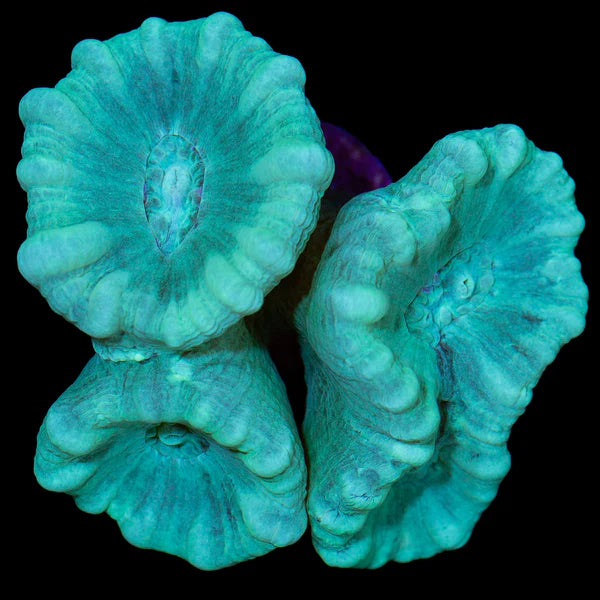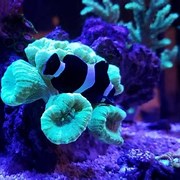Teal Candy Cane Corals
Teal Candy Cane Corals
Candy Cane Corals (scientifically known as Caulastrea spp.) are a popular type of LPS (Large Polyp Stony) coral in the aquarium hobby, known for their vibrant colors and unique appearance, which resembles a candy cane. They are relatively easy to care for, making them a favorite for both beginners and experienced reef keepers. Here's a detailed guide to Candy Cane Coral care:
1. Lighting Requirements
Candy Cane Corals require moderate to low lighting:
- Type of light: They do well under LED or T5 fluorescent lighting. Avoid halide lights unless they are positioned far from the coral, as intense lighting can stress them.
- Light intensity: They thrive under moderate light but can adapt to lower light conditions. Too much light may lead to bleaching.
- Light duration: Around 8–10 hours of light per day is ideal for optimal growth and health.
2. Water Flow
Candy Cane Corals are sensitive to water flow:
- Water movement: A gentle to moderate water flow is ideal. They don’t do well in strong currents, as it can cause their polyps to close or damage the coral.
- Effects of flow: A gentle flow helps them extend their polyps fully, allowing them to feed effectively and maintain a healthy appearance.
3. Temperature and Water Parameters
Candy Cane Corals are tolerant of a range of water conditions but perform best when parameters are stable:
- Temperature: 72–78°F (22–26°C) is ideal.
- pH: 8.1–8.4.
- Salinity: 1.023–1.025 specific gravity.
- Alkalinity: 8–12 dKH.
- Calcium: 400–450 ppm.
- Magnesium: 1250–1350 ppm.
- Nitrate and phosphate levels: These corals are sensitive to poor water quality, so keeping nitrate and phosphate levels low is crucial. Aim for nitrates below 10 ppm and phosphates close to 0.
4. Feeding
Candy Cane Corals are photosynthetic but will also benefit from supplemental feeding:
- Zooxanthellae: Like most LPS corals, Candy Cane Corals host symbiotic zooxanthellae (photosynthetic algae) that help provide nutrients through photosynthesis.
- Supplemental feeding: They will appreciate occasional feedings of small foods like mysis shrimp, brine shrimp, or other planktonic foods. You can also use coral foods, which are available commercially. Feed them about 2–3 times per week, especially if light levels are lower or nutrients from photosynthesis are insufficient.
5. Placement in the Tank
Candy Cane Corals need careful placement for optimal health:
- Location: Place them in a location with moderate to low water flow and moderate lighting. They should not be directly in strong currents, as this can stress them.
- Tank placement: It’s best to place Candy Cane Corals on rocks or frag plugs where they can get enough light, but not where they might be overshadowed by faster-growing corals.
- Distance from other corals: As a stony coral, Candy Cane Corals can produce stinging tentacles and have a moderate aggressive tendency towards neighboring corals. Leave enough space between them and other corals to avoid contact.
6. Propagation and Growth
Candy Cane Corals grow relatively slowly, but they can be propagated easily:
- Growth rate: They grow at a moderate pace, and over time they form small clusters of polyps. With proper care, they can form a dense colony.
- Propagation: Candy Cane Corals can be fragged by cutting through the coral’s skeleton between polyps. Each frag should contain at least one healthy polyp and a section of the skeleton. Fragging should be done carefully to avoid damaging the coral.
7. Common Problems and Issues
- Coral aggression: Although not highly aggressive, Candy Cane Corals can sting neighboring corals, especially if placed too close together. It’s important to give them space in the tank.
- Algae growth: Candy Cane Corals can be prone to algae growth on their polyps if water flow is insufficient or nutrient levels are high. Regular maintenance and good water quality can help prevent this.
- Bleaching: If exposed to excessive lighting or nutrient imbalance, Candy Cane Corals may bleach, losing their vibrant color. Ensure light levels are moderate and water quality is stable.
- Coral recession: If the coral appears to be receding (the tissue is pulling back from the skeleton), this is a sign of poor water quality, insufficient light, or physical damage. It’s important to diagnose and address the underlying issue.
8. Compatibility with Other Species
Candy Cane Corals are generally peaceful but need to be carefully placed in the tank:
- Good tankmates: Peaceful fish and invertebrates, as well as other non-aggressive corals like mushrooms, soft corals, and zoanthids. Avoid placing them near fast-growing, aggressive corals.
- Tankmates to avoid: Aggressive corals like some types of SPS (Small Polyp Stony) corals, as they can outcompete or sting the Candy Cane Coral.
9. Signs of Stress or Illness
- Polyps not extending: If the polyps are not fully extended or are retracted for an extended period, it could be a sign of stress caused by poor water conditions, low lighting, or inadequate flow.
- Deterioration of tissue: Tissue recession (where the coral tissue pulls away from the skeleton) may indicate poor water quality, too much light, or a physical injury.
10. General Tips for Success
- Maintain stable water parameters: This is crucial for the long-term health of Candy Cane Corals. They are sensitive to large swings in temperature, pH, salinity, and other parameters.
- Moderate feeding: Avoid overfeeding, as excessive nutrients can lead to algae growth and poor coral health.
- Regular cleaning and maintenance: Keeping the tank clean and maintaining optimal water flow can help prevent many of the common issues associated with Candy Cane Corals.
Conclusion
Candy Cane Corals are beautiful, low-maintenance corals that are well-suited for a variety of reef tanks. They require moderate lighting, gentle water flow, and stable water parameters to thrive. Regular feeding and proper placement can ensure they grow well and maintain their vibrant colors. By paying attention to their needs, you can enjoy these stunning corals in your tank for years to come!
Couldn't load pickup availability




